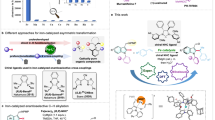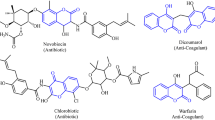Abstract
Understanding the asymmetric catalytic mechanism involving organometallic species provides exceptional insight into the strategies for the degradation of emerging organic contaminants. The present work demonstrates such insights on the oxidation of commonly used non-steroidal anti-inflammatory drugs (NSAIDs) such as diclofenac, paracetamol, ibuprofen, and aspirin using optically active novel Schiff base Co(II) complexes derived from salicylaldehyde containing five different amino acids (L-methionine, L-leucine, L-asparagine, L-tryptophan, and L-glutamic acid). Among the studied chiral catalysts, asymmetric degradation in the presence of a Co(II) complex containing glutamic acid mixed ligand showed an elevated rate of oxidation of non-amine NSAIDs such as ibuprofen (3.86 × 10–2 s−1) and aspirin (3.70 × 10–3 s−1) using H2O2 oxidant under visible light conditions at neutral pH. The formation of chiral intermediate species in both drugs has been detected and characterized by FTIR and Raman analysis. On the other hand, NSAIDs containing secondary amine groups (–NH–), such as diclofenac and paracetamol, generate effective coordination between the complex catalyst and the nitrogen atom. This explains the high activity of the Co(II) complex with glutamic acid mixed salicylaldehyde with 100% selectivity in the degradation of ibuprofen and aspirin. The thermodynamical feasibility of the proposed degradation route for ibuprofen and aspirin was analyzed with theoretically calculated total energy values of all the intermediates formed in each step of the proposed mechanism.
Graphical abstract














Similar content being viewed by others
References
Xiong L et al (2021) Strategies and challenges on selectivity of photocatalytic oxidation of organic substances. Adv Energy Mater 11(8):2003216
Zhan W et al (2019) Recent progress on engineering highly efficient porous semiconductor photocatalysts derived from metal-organic frameworks. Nano-Micro Letters 11(1):1
Kou J et al (2017) Selectivity enhancement in heterogeneous photocatalytic transformations. Chem Rev 117(3):1445–1514
Hao H et al (2018) Modification of heterogeneous photocatalysts for selective organic synthesis. Catal Sci Technol 8(5):1229–1250
Friedmann D et al (2016) Heterogeneous photocatalytic organic synthesis: state-of-the-art and future perspectives. Green Chem 18(20):5391–5411
Mendes-Felipe C et al (2022) Hybrid organic-inorganic membranes for photocatalytic water remediation. Catalysts 12(2):180
Hernández P et al (2022) Development and applications of Ru and Ce based iron oxides as photocatalysts. Mater Lett 313:131720
Haoyue Li et al (2020) Unlocking the potential of photocatalysts in biomass refinery. Chem 6(11):2871–2873
Nathan S et al (2022) Photocatalytic reforming of biomass: what role will the technology play in future energy systems. Top Curr Chem 33:380
Zhang C et al (2019) Asymmetric photocatalysis by intramolecular hydrogen-atom transfer in photoexcited catalyst-substrate complex. Angew Chem Int Ed 58(41):14462–14466
Yao W et al (2022) Asymmetric Photocatalysis enabled by chiral organocatalysts. ChemCatChem 14(1):e202101292
Maalej W et al (2022) Crystal structure and semiconductor properties of copper(II) complex incorporating chiral (R)-(+)-α-Ethylbenzylammonium cations:[(R)-C9H14N]3[CuBr 4] Br. J Solid State Chem 305:122646
Abu-Dief AM et al (2015) A review on versatile applications of transition metal complexes incorporating Schiff bases. Beni-Suef Univ J Basic Appl Sci 4(2):119–133
Lü Y et al (2018) A series of compounds based on [P2W18O62]6– and transition metal mixed organic ligand complexes with high catalytic properties for styrene epoxidation. Inorg Chem 57(17):11123–11134
Lin CK et al (2012) Tunability of band gaps in metal-organic frameworks. Inorg Chem 51(16):9039–9044
Guo Z et al (2017) Lowering band gap of an electroactive metal-organic framework via complementary guest intercalation. ACS Appl Mater Interfaces 9(38):32413–32417
Reinheimer EW et al (2015) Varying the extended packing of silver(I) ladder-like coordination polymers by modifying the organic group of various organosulfonate anions. Polyhedron 98:105–112
Gao C et al (2017) Coordination chemistry in the design of heterogeneous photocatalysts. Chem Soc Rev 46(10):2799–2823
Flood KM et al (1996) Band-gap structure for periodic chiral media. J Opt Soc Am A 13(7):1395–1406
Xu B et al (2014) Structural and functional studies on coordination polymers based on 5-tert-butylisophthalic acid and N, N′-bis-(4-pyridylmethyl) piperazine. RSC Adv 4(49):25588–25595
Bottecchia C et al (2019) Photocatalytic modification of amino acids, peptides, and proteins. Chem A Eur J 25(1):26–42
Refat MS et al (2022) Synthesis and spectroscopic characterizations of nanostructured charge transfer complexes associated between moxifloxacin drug donor and metal chloride acceptors as a catalytic agent in a recycling of wastewater. J Mol Liq 349:118121
Nakagame R et al (2019) Photochemical reaction of amino acid Schiff base derived Cu complexes with extended π-system and their titanium oxide composites. Inorg Chim Acta 486:221–231
Wang G et al (1991) Synthesis and characterization of copper(II) and Zinc(II) complexes of Schiff bases derived from amino acids and 2, 4-dihydroxybenzaldehyde. Synth React Inorg Met-Org Chem 21(5):897–902
Kazemnejadi M et al (2019) Synthesis and characterization of a new poly α-amino acid Co(II)-complex supported on magnetite graphene oxide as an efficient heterogeneous magnetically recyclable catalyst for efficient free-coreductant gram-scale epoxidation of olefins with molecular oxygen. J Organomet Chem 896:59–69
Lu H et al (2012) Stereoselective radical amination of electron-deficient C(sp3)–H bonds by Co(II)-Based metalloradical catalysis: direct synthesis of α-amino acid derivatives via α-C–H amination. Org Lett 14(19):5158–5161
Izadi P et al (2020) Non-steroidal anti-inflammatory drugs in the environment: Where were we and how far we have come? Environ Pollut 267:115370
Hanif H et al (2020) Environmental risk assessment of diclofenac residues in surface waters and wastewater: a hidden global threat to aquatic ecosystem. Environ Monit Assess 192(4):204
Nagesh KP et al (2023) Non-steroidal anti-inflammatory drugs (NSAIDs): A current insight into its molecular mechanism eliciting organ toxicities. Food Chem Toxicol 172:113598
Frisch MJ, et al (2016) Gaussian 16 Rev. A.03. 2016: Wallingford, CT
Guadalupe HJ, Narayanan J, Pandiyan T (2011) Synthesis, molecular structure and spectral analysis: DFT–TDDFT computational study of ruthenium complex of tetradentate N, N′-bis(benzimidazole-2yl-ethyl)-ethylenediamine. J Mol Struct 989(1):70–79
De Joseph CT (1992) Practice of thin layer chromatography, 3rd edn. Wiley, New York
Aleksandra T et al (2017) Bonding interactions in oxydiacetate and thiodiacetate cobalt(II) and nickel(II) complexes. Struct Chem 28:1723–1730
Fatma K et al (2002) Binuclear and mononuclear cobalt(II), nickel(II) and copper(II) complexes of 4,4′-bis(alkylaminoisonitrosoacetyl)diphenyl-methane derivatives. Transition Met Chem 27(8):813–817
Martirosyan GG et al (2019) Comparative FTIR study of the cobalt and iron porphyrin reactions with CO. Does cobalt porphyrin form a bis-carbonyl complex in the Ar matrix? Inorganica Chimica Acta 495:119011
Ehab MZ et al (2023) Ni(II), Co(II), Fe(III), and Zn(II) mixed ligand complexes of indoline-dione and naphthalene-dione: synthesis, characterization, thermal, antimicrobial, and molecular modelling studies. Inorg Chem Commun 147:110276
Sanjeev K et al (2023) Co(II), Ni(II), Cu(II) and Zn(II) complexes of Schiff base ligands: synthesis, characterization, DFT, in vitro antimicrobial activity and molecular docking studies. Res Chem Intermed 49:939–965
Mamdouh SM et al (2023) Synthesis, ligating properties, thermal behavior, computational and biological studies of some azo-transition metal complexes. J Inorg Organomet Polym Mater 33:120–137
Carlos Alberto HA et al (2020) Enhanced photocatalytic degradation of 2-thiobenzimidazole by the tris(8-quinolinolato)-cobalt(III) complex through peroxide adduct formation: theoretical and experimental investigations. New J Chem 44:4786
Necmi D et al (2021) Crystallographic, spectroscopic, thermal, optical investigations and density functional theory calculations for novel Co(II) and Mn(II) complexes. Appl Phys A 127:132
Mandal D et al (2022) Synthesis, characterization, and structure of mixed-ligand Cobalt (II) complex with N, O donor sites. Molbank 2022(3):M1447
Lawrence MAW et al (2015) Synthesis, X-ray crystallographic, electrochemical, and spectroscopic studies of Bis-(1,10-phenanthroline)(2,2′-bipyridine)cobalt(III) Hexafluorophosphate. J Chem Crystallogr 45:427–433
Ruiz AC, Damodaran KK, Suman SG (2021) Towards a selective synthetic route for cobalt amino acid complexes and their application in ring opening polymerization of rac-lactide. RSC Adv 11(27):6326–6338
Li Q et al (2022) New insights into the crystallographic disorder in the polymorphic forms of aspirin from low-frequency vibrational analysis. Mol Pharm 19(1):227–234
Matkovic SR et al (2005) Quantitative analysis of ibuprofen in pharmaceutical formulations through FTIR spectroscopy. Lat Am Appl Res 35:189–195
Shtukenberg AG et al (2017) The third ambient aspirin polymorph. Cryst Growth Des 17(6):3562–3566
Hug WF, et al (2020) Deep UV Raman and fluorescence spectroscopy for real-time in situ process monitoring. In Proc.SPIE
Bianchi CL et al (2017) Aspirin and paracetamol removal using a commercial micro-sized TiO2 catalyst in deionized and tap water. Environ Sci Pollut Res 24(14):12646–12654
Li L et al (2018) Photocatalytic performance and degradation mechanism of aspirin by TiO2 through response surface methodology. Catalysts 8(3):118
Lin L et al (2019) Adsorption and photocatalytic oxidation of ibuprofen using nanocomposites of TiO2 nanofibers combined with BN nanosheets: degradation products and mechanisms. Chemosphere 220:921–929
Wang C et al (2016) Insights of ibuprofen electro-oxidation on metal-oxide-coated Ti anodes: kinetics, energy consumption and reaction mechanisms. Chemosphere 163:584–591
Hao H et al (2005) Enantioselective Pharmacokinetics of Ibuprofen and Involved Mechanisms. Drug Metab Rev 37(1):215–234
Acknowledgements
Authors gratefully acknowledge COMECYT (Consejo Mexiquense de Ciencia y Tecnología, Folio: FICDTEM-2021-047), Estado de México, for the financial support through “Financiamiento para Investigación de Mujeres Científica EDOMEX-FICDTEM-2021-01”. Also, acknowledge DGTIC (Dirección General de Cómputo y de Tecnologías de Información y Comunicación) of Universidad Nacional Autónoma de México (UNAM) for the computational services.
Author information
Authors and Affiliations
Contributions
Susana Dianey Gallegos Cerda participated in methodology and data curation. Carlos Alberto Huerta Aguilar participated in software, data curation, and validation. Miguel Morales Rodríguez participated in the resources and formal analysis. Jose Antonio Juanico Loran participated in the XRD studies. Jayanthi Narayanan participated in conceptualization, validation, writing the original draft, writing the review, and editing. All authors reviewed the manuscript.
Corresponding author
Ethics declarations
Competing interests
The authors declare no competing interests.
Additional information
Publisher's Note
Springer Nature remains neutral with regard to jurisdictional claims in published maps and institutional affiliations.
Supplementary Information
Below is the link to the electronic supplementary material.
Rights and permissions
Springer Nature or its licensor (e.g. a society or other partner) holds exclusive rights to this article under a publishing agreement with the author(s) or other rightsholder(s); author self-archiving of the accepted manuscript version of this article is solely governed by the terms of such publishing agreement and applicable law.
About this article
Cite this article
Cerda, S.D.G., Aguilar, C.A.H., Singh, J. et al. Selectivity through an asymmetric pathway in the degradation of non-steroidal anti-inflammatory drugs (NSAIDs) using mixed-ligand cobalt(II) complexes: experimental and theoretical insights. Transit Met Chem 48, 401–414 (2023). https://doi.org/10.1007/s11243-023-00553-8
Received:
Accepted:
Published:
Issue Date:
DOI: https://doi.org/10.1007/s11243-023-00553-8




